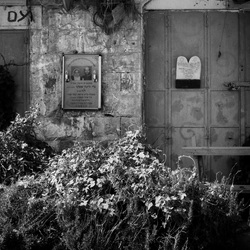Go To Hebron
|
Hebron is the largest city in the West Bank and the second largest in the Palestinian territories after Gaza, It is home to approximately 250,000 Palestinians and between 500 and 850 Jewish settlers concentrated in Otniel settlement and around the old quarter. After the Six-Day War in June 1967, Israel occupied Hebron along with the rest of the West Bank. Following the 1995 Oslo Agreement and subsequent 1997 Hebron Agreement, Hebron was split into two sectors: H1 is controlled by the Palestinian Authority and H2 controlled by Israel.
I visited Hebron in 2010, when these pictures were taken. Walking in the narrow streets of the city center, one has the impression to be in a place where space has changed into something different: not something to go through, but a dense and unstable matter one has to continuously pay attention to, reconfiguring her own movements and forcing her gaze into noticing and recognizing unexpected borders and ruptures. Nets to stop stones thrown by Israeli settlers on the people in the market, check points, walls, fences, roads where Palestinians are not allowed to drive their cars or even walk, gratings, abandoned houses, doors on which the star of David has been painted by Israeli settlers as a form of claiming. All these material and symbolic forms of closure and exclusion are the very matter of which space in Hebron and the life of people living in it are made of. Go to Hebron, a title inspired by the j’accuse launched in 2009 by Ori Nir, the spokesman of Americans for Peace Now, tries to convey this idea of place, as a closed, fragmented space in which persons, debris, walls, faces, fences, houses etc., all concur in creating a feeling of isolation, of solitude, of the lack of certainty, of the impossibility of belonging, of a time whose flow has been interrupted or keeps being interrupted. “Go to Hebron. Observe how several hundreds of ultra-national Israeli settlers, a minority in a Palestinian town of 160,000, have turned the lives of its Palestinian residents into a living hell. […] Go to Hebron. You will see how the Jewish settlers and Israel’s military government have aggressively turned what used to be the centre of town—the business and trade centre of the southern part of the West Bank—into a Jewish dominated enclave. Palestinians are not allowed to walk—let alone drive—through the long main street of downtown Hebron. They are subject to constant daily harassment by the settlers and the army. […] If you want to see what the relationship between Israelis and Palestinians will turn into if we don’t start reversing the escalating status-quo of Israeli occupation in the West Bank, go to Hebron.” From “Go to Hebron”, Ori Nir, 2009. |
|

















